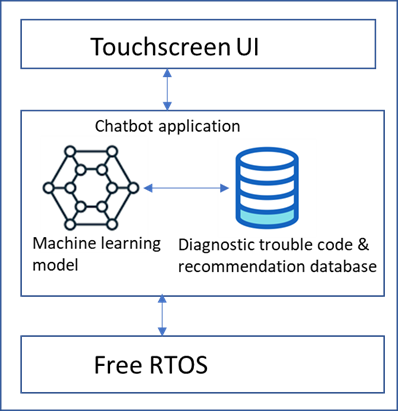ABSTRACT
This white paper proposes an offline chatbot solution for vehicle diagnostics that uses machine learning algorithms to diagnose vehicle problems accurately and efficiently. The chatbot is trained using a dataset of diagnostic codes and their associated recommendations. The system is integrated into the vehicle as part of the infotainment system. We discuss the required hardware and software specifications for this system in this paper. The trained model can be deployed as embedded C or C++ application in the vehicle. Offline chatbot system enables faster diagnostics as it enables quick access to diagnostic data for technicians.
Keywords: Chatbot, Machine Learning
Introduction
The automotive industry is constantly evolving, with advancements in technology making vehicles more complex than ever before. As a result, diagnosing vehicle problems has become increasingly difficult, requiring specialized knowledge and skills. To address this challenge, there is a need for innovative solutions that can accurately and efficiently diagnose vehicle issues. One such solution is an offline chatbot for vehicle diagnostics, which uses machine learning algorithms to provide accurate and efficient diagnostic results. This white paper proposes such a solution, which is designed to be integrated into the vehicle itself and offers significant benefits over traditional diagnostic methods. In this paper, we will describe the proposed solution in detail, including its architecture, implementation, and benefits, as well as real-world examples of successful diagnoses.
System Overview

Figure 1: Offline Chatbot system overview
The proposed system is an integrated, offline chatbot solution for vehicle diagnostics. Its purpose is to diagnose vehicle issues accurately and efficiently by using machine learning algorithms trained on a dataset of diagnostic codes and their recommended solutions. To operate, the system requires specific hardware and software components, including a microcontroller unit, memory, and an operating system. The chatbot interacts with the user via a user interface, such as a touchscreen display or voice recognition, and communicates the diagnosis results and recommended solutions.
To operate the chatbot solution, the system requires a microcontroller unit (MCU) capable of running the chatbot’s algorithms and data. For this application, a recommended MCU is the ARM Cortex-M series, with sufficient processing power and memory. In addition, the system has a minimum memory capacity of 512KB of flash memory and 128KB of RAM to store the chatbot application, diagnostic codes, and associated recommendations. To interact with the user, the chatbot requires a user interface, which can be achieved through a touchscreen display.
The system has FreeRTOS operating system that is compatible with the chosen MCU. The chatbot application is programmed in C programming language. We have used Scikit-learn for development of the chatbot’s machine learning algorithms.
Model development and training process

Figure 2: Model training process
The proposed system’s training data and machine learning process consist of the following steps:
Benefits of offline chatbot system
The chatbot system for vehicle diagnostics has several advantages over traditional diagnostic methods. It provides accurate and efficient diagnoses, which can lead to faster repairs and reduced downtime for the vehicle owner. The chatbot can also offer recommendations for repairs or maintenance, potentially saving the owner money on unnecessary repairs.
Real-world scenarios where the chatbot has successfully diagnosed and resolved vehicle issues include:
Overall, the offline chatbot system for vehicle diagnostics is a valuable tool for both vehicle owners and professionals in the automotive industry. Its accuracy, efficiency, and ease of use make it an asset for diagnosing and resolving vehicle problems.
Conclusion
To summarize, the offline chatbot solution for vehicle diagnostics provides an accurate and efficient method for diagnosing vehicle problems. Using machine learning algorithms and a trained dataset of diagnostic codes, the chatbot can quickly and effectively provide diagnosis results and recommended solutions. The implementation and deployment process are straightforward, and the system can be easily integrated into a vehicle’s hardware and software.
The offline chatbot system offers numerous benefits, such as improved accuracy and efficiency, reduced costs, and improved customer satisfaction. Overall, the offline chatbot system for vehicle diagnostics is a promising technology that can significantly enhance the vehicle repair and maintenance process.
